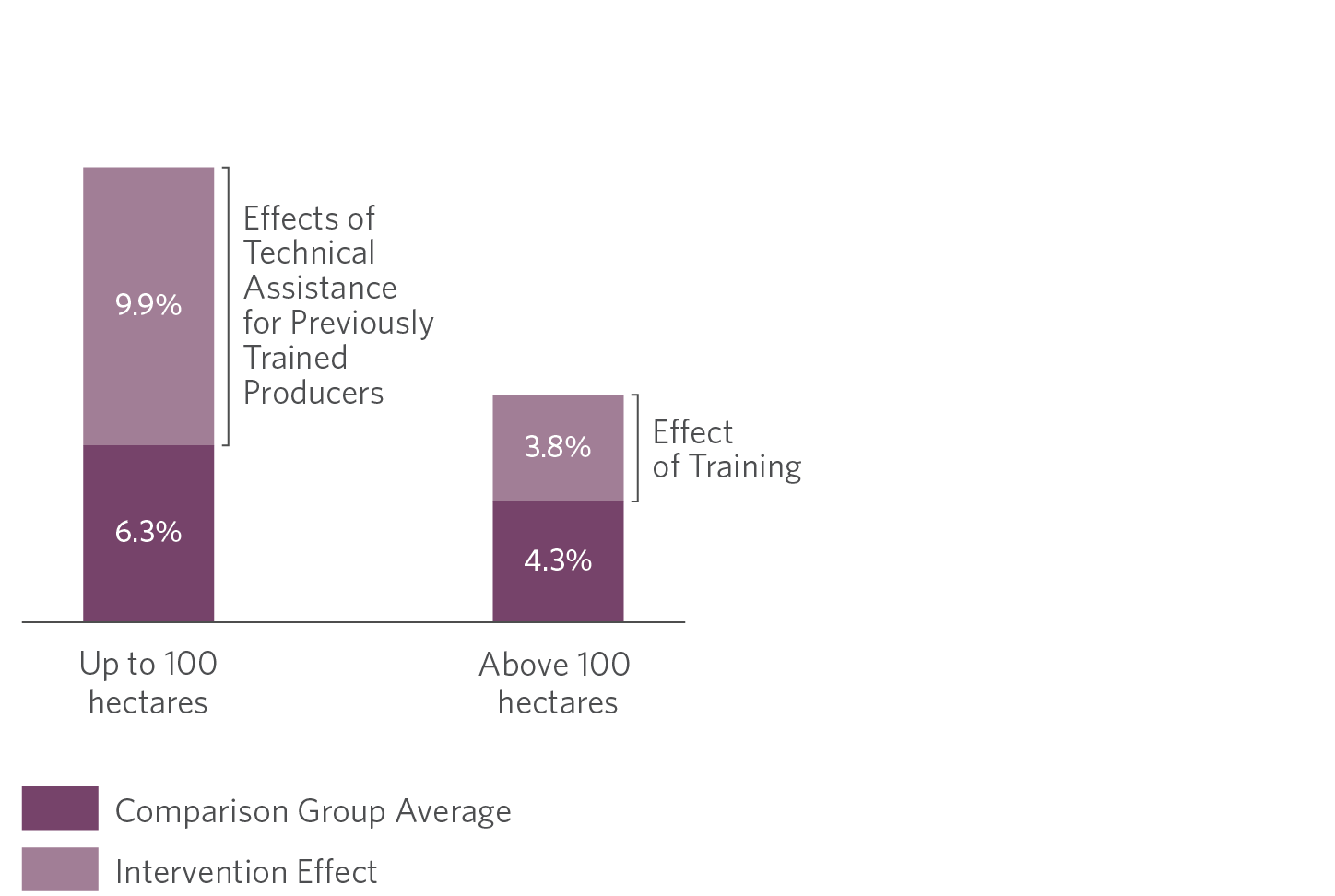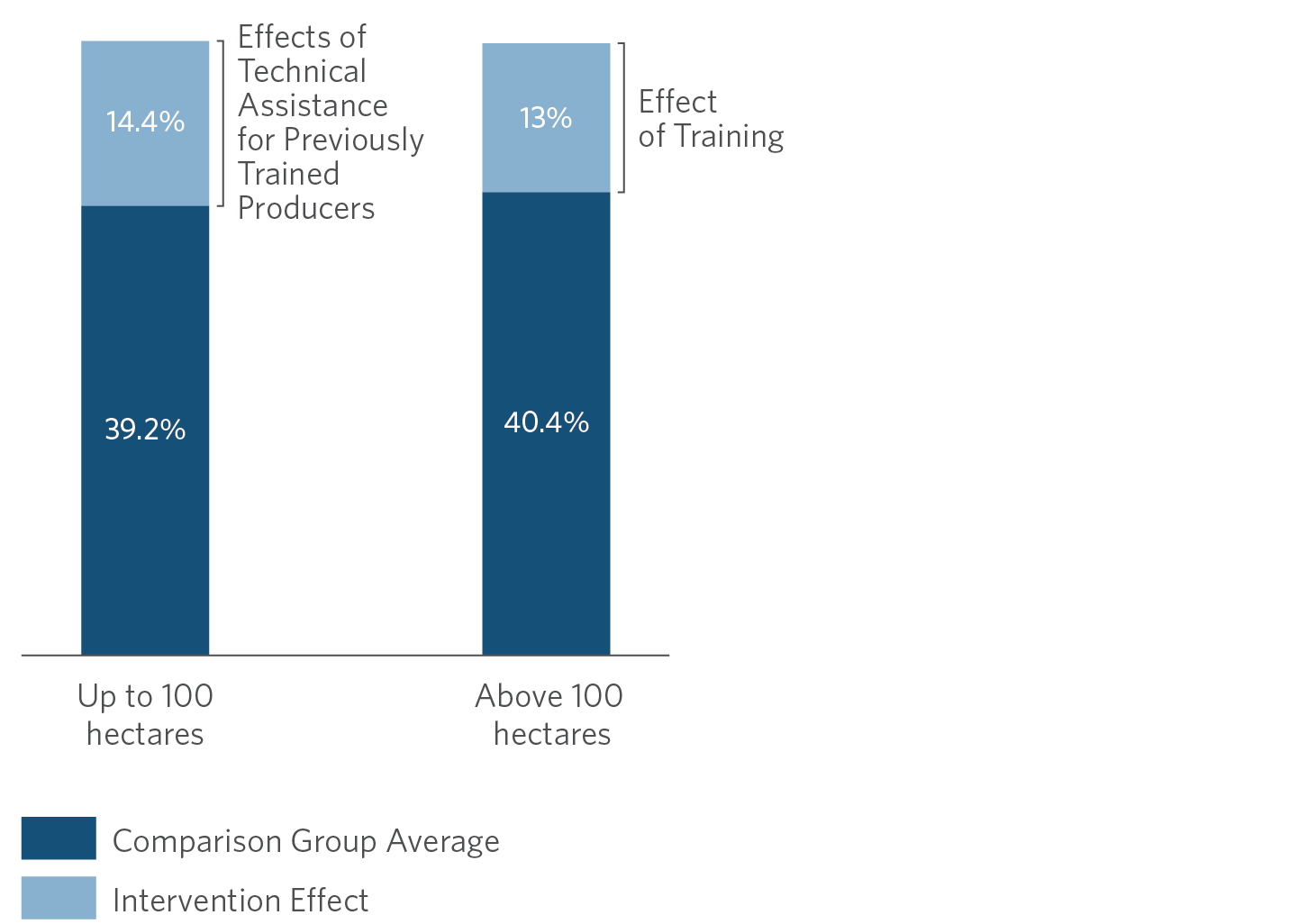Promoting sustainable agriculture practices is crucial to tackling the challenges posed by climate change. Rural extension – i.e., the set of initiatives aimed at providing knowledge to rural producers – is essential to implementing modern management techniques that reduce environmental impacts. However, adoption of such practices can be costly, despite the significant economic returns they generate through increased productivity.[1] Multiple factors, such as financial constraints and lower schooling levels, can create difficulties for rural producers when implementing the knowledge made available by rural extension.
Brazil faces challenges in fostering sustainable agriculture and reducing the pressure for deforestation. With this objective in mind, the ABC Plan,[2] developed for the 2011 to 2020 decade – and with a new phase called the ABC+ Plan for the 2021 to 2030 decade – is the main government initiative to reduce emissions in Brazilian agriculture, including ambitious targets for pasture restoration. One of the projects implemented in this period was the ABC Cerrado,[3] a rural extension project that received R$ 23 million[4] to finance training and technical assistance for rural producers to adopt sustainable management techniques, focusing on the restoration of degraded pastures. It should be noted that more than half of all pasture areas in Brazil feature some level of degradation.[5]
In this study, researchers from the Climate Policy Initiative/Pontifical Catholic University of Rio de Janeiro (CPI/PUC-Rio) evaluate the impact of training and technical assistance delivered by the ABC Cerrado Project and provide resource-channeling options aimed at achieving greater adoption of sustainable practices in rural areas. In a previous evaluation, Bragança et al. (2022)[6] showed that, on average, technical assistance to rural producers combined with training generates significant increases in pasture restoration and productivity. However, there is no impact when training occurs in isolation. This study extends the previous analysis to assess how the effects differ by producer scale.
The results suggest that the training only works for ranchers operating in larger areas, which raises the question of what characteristics these producers have that enable the implementation of the techniques taught.[7] While training alone is ineffective for small-sized ranchers, the technical assistance yields concrete gains to previously trained smaller producers, allowing them to adopt the practices. On the other hand, technical assistance adds little for larger producers, who already have implementation capacity with training alone. It is worth noting that those are short-term effects directly driven by the intervention. As ranchers implement the techniques and observe productivity gains, they may further expand their restoration practices and disseminate the techniques to their families, neighbors, cooperative members, and their network of contacts.
Therefore, there is room to rationalize resource use and make public policies more effective. Offering training courses is cheaper, so it could be provided to all producer profiles, thus promoting a significant increase in pasture restoration for larger, more educated, and less financially constrained ranchers. On the other hand, the provision of technical assistance, a more costly intervention, can be targeted to small ranchers, who are generally less educated, with less investment capacity and more obstacles to accessing credit. Technical assistance has its maximum effects on this group. As assistance adds little to larger-sized ranchers, who can implement the practices only with training, targeting the assistance to the small ranchers is a way to facilitate the expansion of rural extension projects and maximize the positive impact on land use. This policy can also be complemented by initiatives that promote content assimilation and alleviate financial constraints to implementing the taught practices.
MAIN FINDING AND PUBLIC POLICY IMPLICATIONS
• The recovery of degraded pastures increases cattle productivity, thus allowing for the expansion of Brazilian livestock production without loss of the native vegetation.
• More than half of the pasture area in the country has some level of degradation. It is possible to restore those areas with proper management techniques. The ABC Cerrado project seeks to instruct rural producers on how to implement those practices.
• Offering training courses to larger-sized ranchers with higher schooling levels and fewer financial restrictions is sufficient to affect pasture restoration positively.
• For smaller-sized ranchers, training is not effective alone. However, by offering technical assistance with monthly visits to facilitate the implementation of the technologies taught, the project can induce pasture restoration.
• Offering technical assistance after training adds little to larger producers: the implementation of technologies already occurs only with training for this group.
• The effects of both interventions on rotational grazing occur in the same direction as those reported for pasture restoration.
• As technical assistance is substantially more expensive, it is possible to amplify the project scale cost-effectively by offering training to every producer and technical assistance focused on small producers.
ABC Cerrado Evaluation
This work aims to understand how the instruction of rural producers offered by the ABC Cerrado Project can contribute to restoring degraded pastures.[8] Pasture degradation is mainly due to inadequate management practices – for example, high levels of soil compaction and the incidence of diseases – resulting in significant productivity loss. Pasture restoration entails a set of techniques for proper soil management and fodder plant cultivation, following specific criteria for each area. Adopting such practices reduces the need to clear new areas for pasture, thus reducing the pressure for deforestation. By improving soil quality and mitigating the risk of pests, the practices increase cattle productivity, reducing the need to increase extensive cattle-raising activities.
The work evaluates the project’s impacts on the proportion of recovered pastures and the adoption or not of rotational grazing, which consists of the segmentation of the pasture area and cattle rotation between these areas, allowing fields to recover in fallow periods between grazing cycles.
The ABC Cerrado Project includes two types of rural extension: training and technical assistance. Training consists of 56-hour courses taught by instructors trained by the National Service of Rural Learning (SENAR). The analyzed courses consist of lectures for groups of about 20 ranchers about techniques related to pasture restoration. Technical assistance is based on monthly visits (over a period of 20 months) by technical staff to the properties in which they prepare a customized action plan to implement the new practices, providing follow-up and support to producers throughout the entire process.
The analysis uses data from the ABC Cerrado Project in which ranchers were randomly sorted into three groups: the control group, which did not receive any intervention; the group that received only the training component; and the group that received both training and technical assistance. More information on the evaluation design can be found in the Methodology section at the end of this document.
The studied sample comprises ranchers interested in pasture restoration. Most of these producers are small-sized: 72% had properties whose areas were smaller than four fiscal modules,[9] and 84% declared an Annual Gross Agricultural Revenue (Receita Bruta Agropecuária Anual – RBA) of at most R$ 360 thousand[10] in 2017. To understand how effects vary according to property size, results are presented separately for producers with property areas up to and above 100 hectares, a value close to the median area of the sample.
The main finding of the analysis is that isolated training has a positive effect only on larger properties, while technical assistance for previously trained producers affects only smaller-sized ranchers, as shown in Figure 1. The combined impact of training and technical assistance is positive for all sizes of properties, both in pasture restoration and in the adoption of rotational grazing.
Figure 1. Effects of Training and Technical Assistance on the Share of Recovered Pastures and the Probability to Adopt Rotational Grazing
Note: The coefficients shown in the graph are differences in means between groups adjusted by a series of controls, comparing as follows: 1) The difference between T1 and T0 gives the training effect; 2) The difference between T2 and T1 gives the effect of technical assistance for previously trained producers. The coefficients are significant at
a 90% level of statistical significance.
Source: CPI/PUC-Rio with data from Bragança et al., 2022
For ranchers operating in areas above 100 hectares, training almost doubles the share of restored pastureland. More precisely, having participated in the training implies an increase of 3.8 percentage points in the proportion of pastures restored (over an average of 4.3% for those who were not trained). In absolute terms, this implies an increase of about 15 hectares recovered per larger-sized trained producer.[11] In addition, training increases the probability of adopting rotational grazing by 13 percentage points (over an average of 40.4% of those who did not receive training). These results suggest that, for this group, training is sufficient to generate positive outcomes. Conditional on the fact that they were previously trained, larger-sized ranchers do not further increase the adoption of sustainable pasture practices with technical assistance, as the effects found are not statistically significant.
For smaller-sized ranchers (100 hectares or less), training alone had no significant effect on restoration and rotation practices. On the other hand, when combined with technical assistance, producers adopted the taught practices. For these smaller producers, technical assistance increased the proportion of recovered pastures by almost ten percentage points (over an average of 6.3% among those who were only trained) and by 14.4% the probability of adopting rotational grazing (over an average of 39.2% among those who were only trained). In absolute terms, each producer in this group can recover an average of 5 hectares of pasture with technical assistance.[12] For this group, results suggest that training is insufficient to promote the adoption of practices, and the combination with technical assistance becomes crucial.
It is worth noting that the estimated effects only capture the policy’s direct impact in the short term, measured immediately after the intervention. It is expected that, by implementing the techniques and observing productivity gains, producers will continue to increase pasture restoration and adopt practices such as rotational grazing over time.
Considering all properties in the sample without distinction of size, the average effects of training are not significant, which is in line with previous studies.[13]
However, the impact of combining training with technical assistance is positive and significant, as demonstrated by Bragança et al. (2022). Producers who were targeted by the combined intervention restored more pasture areas, more often adopted good rural management and environmental conservation practices, invested more in inputs and machinery, and even achieved greater productivity gains.
The present study shows a relevant heterogeneity behind these results: the desired outcome of the policy is achieved with training for larger-sized ranchers, who depend less on technical assistance for implementing practices. On the other hand, small-sized ranchers rely heavily on technical assistance to implement the techniques.
This heterogeneity between larger and smaller producers can have several explanations. First, property size is related to producers’ ability to make their own investments, which can impact restoration. In this respect, larger-sized ranchers, who have more income and land, are in an advantageous position relative to small-sized ranchers. Table 1 shows that larger producers are more likely to invest in equipment such as tractors, machinery, vehicles, or implements. It is observed that 79% of these producers report having this equipment before the experiment, compared to 60% for small producers. In addition, 60% intend to invest more in this equipment in coming years, compared to 47% of small producers.
Table 1. Rancher Characteristics by Property Area (%)
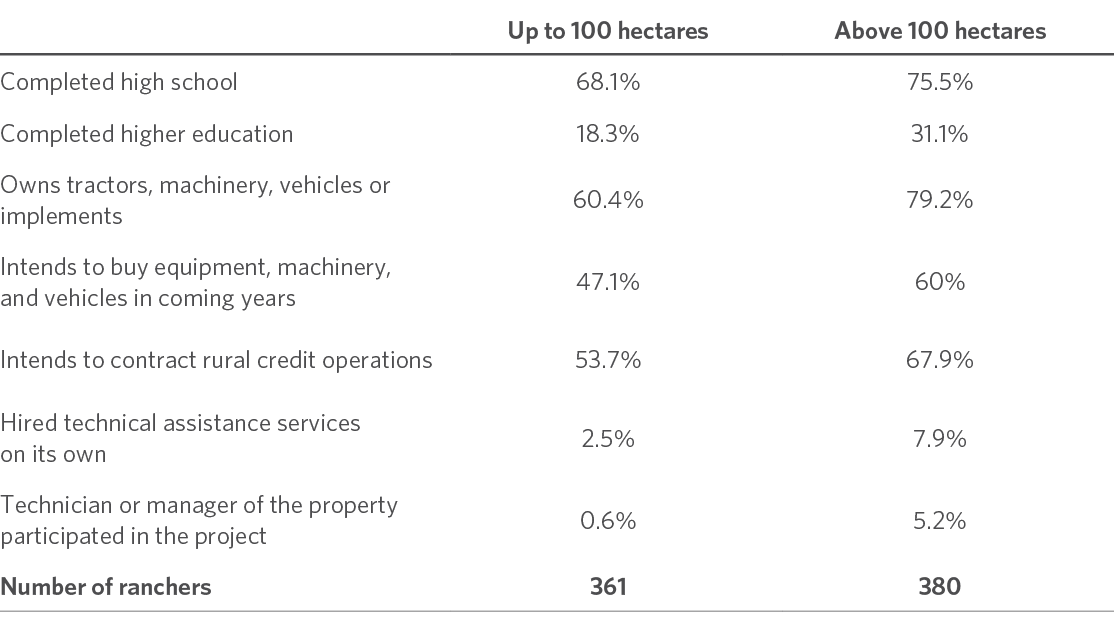
Note: The values represent the percentage of producers of each property size that shows the feature in each row. All variables were measured in the period before the experiment to avoid confounding measures with possible effects that the intervention itself may have had on responses.
Source: CPI/PUC-Rio with data from Bragança et al., 2022
In addition to their own resources, ranchers operating on a larger scale also intend to contract rural credit operations more frequently, which can help finance higher-value equipment: 68% of larger producers intend to get credit, compared to 54% among smaller ones. This difference may reflect a coarser credit constraint on small producers.
Schooling is another relevant factor related to learning and implementing techniques. Larger-sized ranchers tend to be more educated on average: 31% of producers in areas above 100 hectares have completed higher education, compared to 18% for small producers. The proportion of producers completing at least high school is also higher among larger ranchers.
Finally, larger producers also tend to hire technical assistance on their own more frequently and show a higher proportion of technicians and managers participating in the project. However, as the ratios in both groups are low, none of these factors seem relevant to explain the results found.
To test the relevance of these mechanisms to explain the results presented in Figure 1, the project effects were calculated by interacting the property size variable with some of the characteristics shown in Table 1.[14] Some interesting patterns were found.
Both the effect of training for larger-sized ranchers and the effect of technical assistance for small-sized ones are significant only for those who had equipment before the experiment. For those who did not, the impact is not statistically significant. There is a very similar pattern for the intention to obtain credit operations. These results, valid for restoration and rotation, suggest that the cost of implementing the techniques may be substantial, as having more access to resources correlates with implementing the techniques taught.
Higher schooling also seems relevant to maximize the effects of rural extension. In the case of rotational grazing, both the impact of training for larger-sized ranchers and the effect of technical assistance for smaller ones are higher for those who have at least completed high school. For recovered pastures, the same pattern shows up for the effect of technical assistance for smallholders. Larger-sized ranchers show similar training effects having or not completed high school.
The estimates suggest that all these characteristics are associated with pasture restoration and rotational grazing results. Future research must deepen this investigation of the mechanisms, mainly seeking to explain the limitations related to the effects of training for smaller-sized ranchers.
Policy Implications
The ABC Cerrado impact evaluation generates evidence on the effects of rural extension on adopting sustainable agricultural management practices. This work indicates that the effect of training through courses on pasture restoration and rotational grazing is only positive and significant in larger properties. Smaller-sized ranchers who undergo training adopt such practices with similar intensity as those not targeted by the intervention. Smaller producers who, in addition to training, receive technical assistance significantly improve their outcomes. Larger producers, on the other hand, do not have a relevant increase in their outcomes with technical assistance besides the effect already achieved with training.
Several mechanisms can explain why training is insufficient for smallholder ranchers to adopt sustainable practices. First, producers with fewer resources have less capacity to invest when compared to larger producers, thus restricting the capacity to bear expenses associated with implementing new technologies. Second, larger-sized ranchers generally have more access to credit, as they are better able to offer collateral. With better financial services available, those ranchers can access risk management instruments such as rural insurance, which facilitate investments and modernization. Third, taught practices can have relevant economies of scale, facilitating implementation by larger producers. Finally, larger producers tend to be more educated, thus having more human capital and a greater capacity to understand and benefit from training.
These findings pose important considerations for policymakers. The main takeaway of this policy brief is that each component of the rural extension policy can focus on different producer profiles. Training may be sufficient for larger-sized ranchers who can better implement the technologies. On the other hand, smaller ones need technical assistance to advance in pasture restoration.
Training is considerably cheaper compared to technical assistance. The estimated cost of training per producer in the project was R$ 1,100, while that of assistance was R$ 5,700. In other words, technical assistance costs more than five times more than training, on average.[15] Therefore, the policy can offer training for producers of all sizes and focus on technical assistance for smaller ranchers to expand the scale of the intervention cost-effectively.
The effects discussed in this evaluation are in the short term. The policy returns are expected to be higher in the long run. Ranchers tend to increase investment in restoration practices as they observe productivity gains with the adoption of techniques over time. In addition, producers who participated in rural extension tend to spread knowledge about the restoration practices to their families, neighbors, cooperative members, and other contacts.
Finding ways to increase pasture restoration is essential to substantially reduce environmental impacts in a country where the loss of native vegetation is the main responsible for greenhouse gas emissions.[16] Therefore, combining courses for small producers with other interventions is crucial to maximizing positive effects on land use. In ABC Cerrado, technical assistance was essential to implementing sustainable practices.
The ABC+ Plan has ambitious targets to promote sustainable agricultural practices between 2021 and 2030. The targets include recovering 30 million hectares of degraded pastures, which has the potential to reduce CO2 equivalent emissions by 113.7 million tons. The ABC Cerrado Project, implemented in the first phase of the ABC Plan, provides relevant evidence for policymakers to develop and improve programs. The project’s experience reveals that productivity gains, more efficient land use, a significant reduction in environmental impact, and the relatively low cost of the intervention justify combining training courses with technical assistance, especially for small ranchers.
Methodology
The data used in this policy brief comes from a randomized evaluation of the ABC Cerrado Project, funded by the World Bank and implemented by SENAR. The first results were published by Bragança et al. (2022). The data collection to evaluate rancher training and technical assistance interventions occurred on two occasions: before training (in 2017) and close to the end of the technical assistance period (in 2019). Researchers collected information on adopting sustainable practices, producers’ and properties’ profiles, expenditures, and revenues associated with rural activities.
As shown in Figure 2, the analysis focuses on 1,369 producers initially interested in technical assistance. They were randomly assigned into three groups: those who did not receive any intervention (neither training nor technical assistance), those who completed the training but did not receive technical assistance, and those who completed training and received assistance. SENAR tried to collect random samples of equal size for each of these groups. In the first group, it was possible to obtain data from 213 of the 663 ranchers (T0 group). In the second group, data were obtained from 252 of 395 ranchers (T1 group) and, in the third group, 276 of 311 (T2 group). The total study sample, therefore, contains 741 ranchers.
Figure 2. Sample Selection of Ranchers
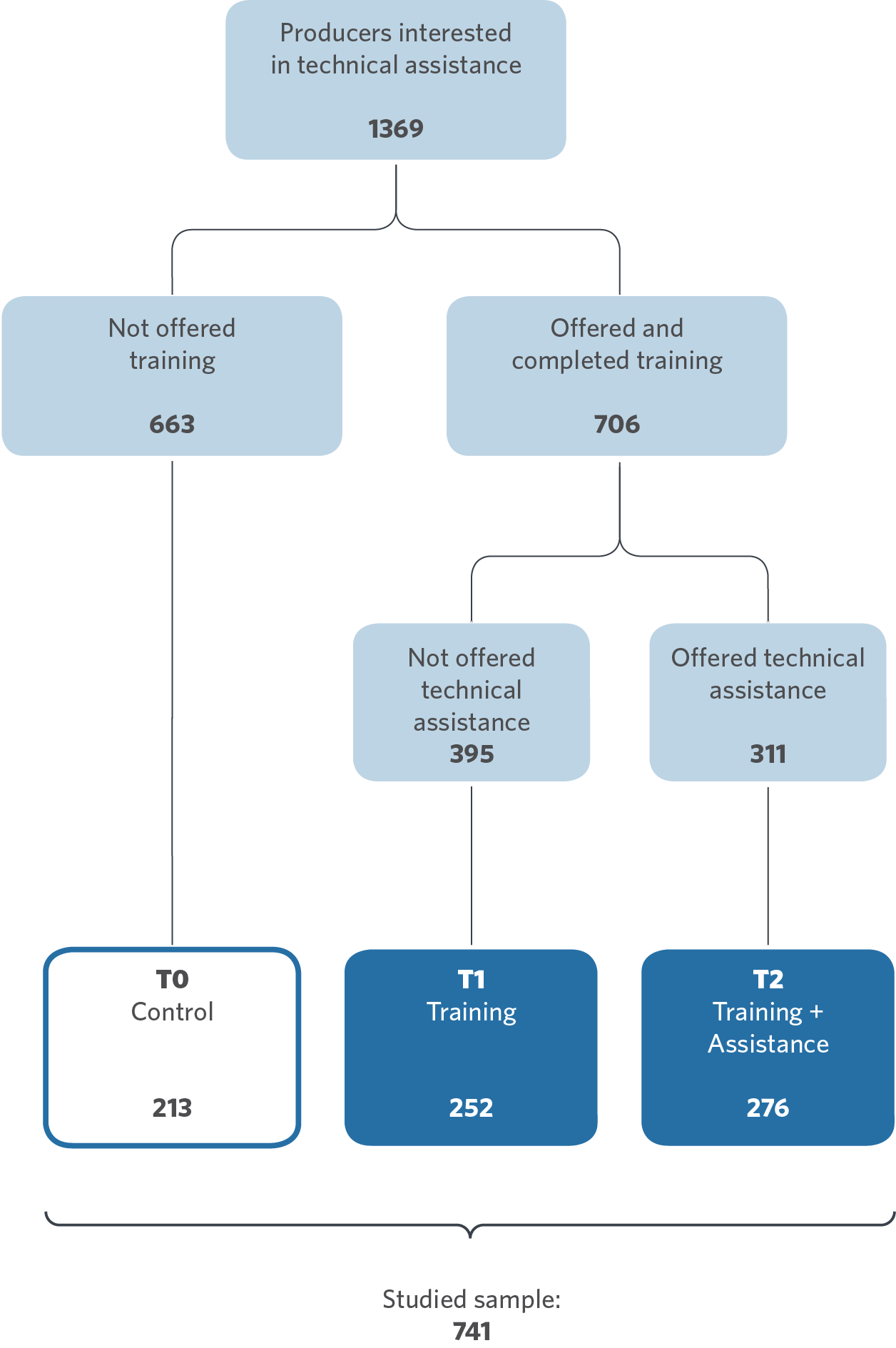
Source: CPI/PUC-Rio with data from Bragança et al., 2022
To measure the causal effect of training on adopting sustainable practices, we calculated the difference between the average of the variable of interest in the group selected to receive only training (T1) and in the group that was not the target of any intervention (T0). The effect of technical assistance, given that producers were previously trained, is calculated by comparing the group that received both interventions (T2) and the group that received only training (T1). Finally, the effect of combining the two interventions is the difference in means between the group that received all interventions (T2) and the control group without any intervention (T0).
In all cases, the averages of each group are adjusted for a series of producer characteristics: year of birth and sex of the rancher, variables that indicate whether the rancher lives on the farm if the farm is the primary source of income and if the rancher is a cooperative member. In other words, the effects found cannot be attributed to any differences in these characteristics between the evaluated groups. In any case, as there was a lottery to define participation in each group, these differences, even if they exist, are minor and do not affect the result in any relevant way. The gain in including these variables is due to the increase in the precision of the estimates.
To separate producers according to size, we used the value of 100 hectares, approximating the median property area reported before the experiment, 102 hectares. The choice of the 100 hectares cutoff to split the sample was made to simplify the exposition. The results are unchanged if we precisely use the value of 102.
The distribution of producers by area is more homogeneous up to 100 hectares, given that the first quartile is defined between 0 and 46 hectares, therefore very close to 50. On the other hand, above 100 hectares, ranchers are much more heterogeneous. Although the third quartile is limited by 250 hectares (so a quarter of the sample is between 100 and 250), the last quartile of the sample varies from 250 to more than 2,000 hectares. This fact explains why the average property area (427 hectares) for ranchers above the median for the full sample (T0, T1, and T2) is much higher than the upper bound of the third quartile of the sample.
Table 2 shows the detailed evaluation results according to the property size:
Table 2. Results from the Estimation of Training and Technical Assistance Effects According to Property Size
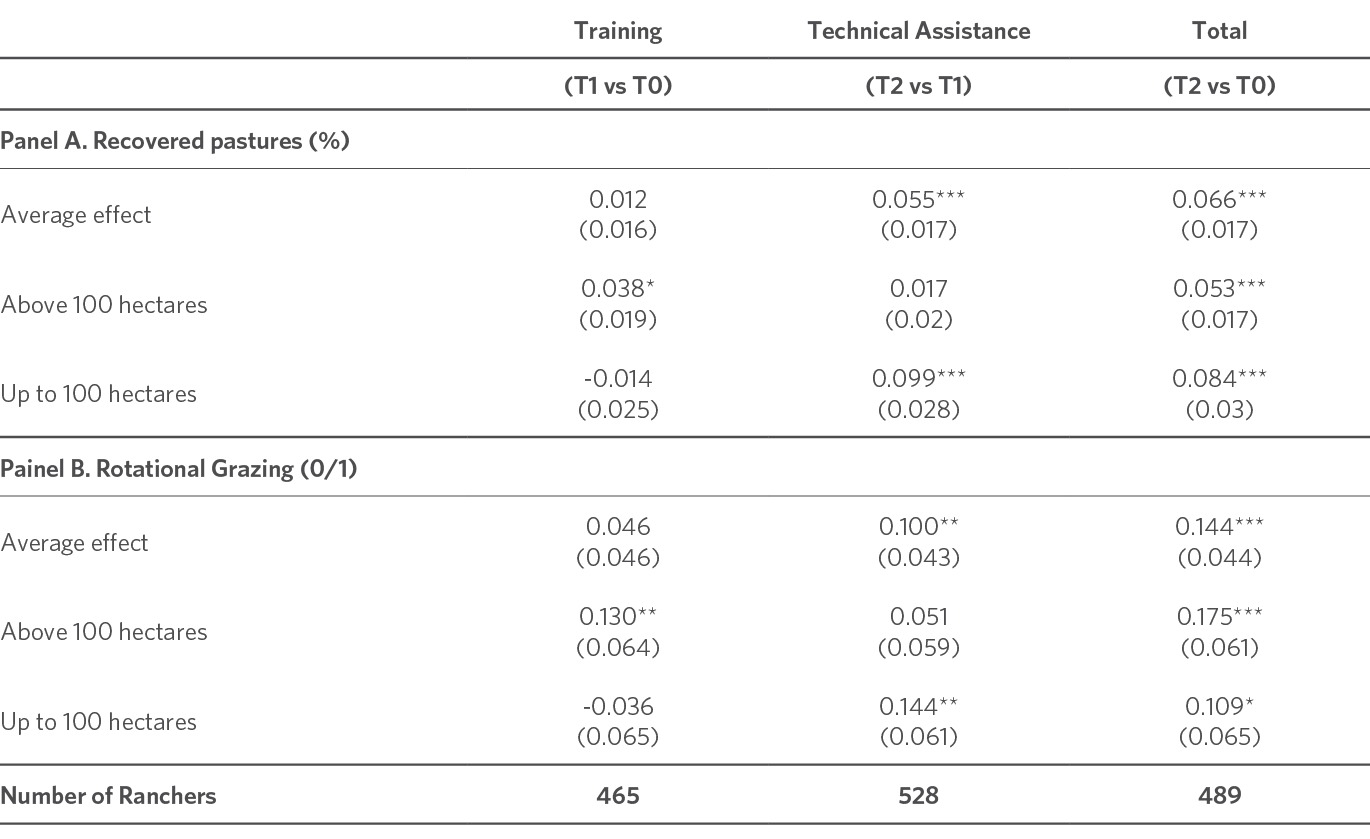
Note: The table reports the results of the randomized evaluation of the ABC Cerrado Project. The coefficients come from linear regressions where the dependent variable is the proportion of recovered pastures (%) in panel A and an indicator (0/1) if the producer adopts rotational grazing in panel B. In column T1 vs T0, the regressor is an indicator equal to 1 if the producer only participated in the training and 0 if they are in the control group, which was not the target of any intervention. In column T2 vs T1, the indicator is equal to 1 if the producer received, in addition to training, technical assistance, and 0 if they received only training. It is, therefore, the effect of technical assistance for previously trained producers. In column T2 vs T0, the comparison occurs between producers who received the complete intervention (training and technical assistance) and the control group without any intervention. In this case, we have the total effect of the policy. All regressions are controlled by the producer’s year of birth and gender, in addition to variables that indicate if the producer lives on the property, if the farm is their main source of income and if they are part of a cooperative. The first line shows the average effects. The second and third lines report heterogeneous effects according to property size, defined as above or up to the value of 100 hectares, approximately equal to the median property area reported before the experiment, which is 102 hectares. Standard errors robust to heteroskedasticity are reported in parentheses. * denotes p-value of the statistical significance test less than 0.1; ** less than 0.05; and *** less than 0.01.
Source: CPI/PUC-Rio with data from Bragança et al., 2022
The authors would like to thank Cristine Camboim (SENAR), Diego de Faveri (FGV EBAPE), Sidney Medeiros (Ministério da Agricultura), and Soraya Araújo (Ministério da Agricultura) for their valuable contributions. They would also like to thank Beatriz Baptista for research assistance, Juliano Assunção, Natalie Hoover El Rashidy, Giovanna de Miranda, and Camila Calado for the editing and revision of the text, and Nina Oswald Vieira and Julia Berry for formatting and graphic design.
[1] For example, for beef cattle, it is estimated that pasture areas recovered using ABC Cerrado techniques yield productivity gains of around 1.8 more animal units per hectare, in addition to an average weight gain of 500g/day and a 17-month reduction in time to harvest (CNA. ABC Cerrado. Cerimônia de Apresentação de Resultados. 2019. bit.ly/3gn6dqw. Access date: September 22, 2022).
[2] The ABC Plan is the Sectoral Plan for Climate Change Adaptation and Low Carbon Emission in Agriculture.
[3] The project is implemented by the Ministry of Agriculture, Livestock and Food Supply (Ministério da Agricultura, Pecuária e Abastecimento – MAPA) in partnership with the Brazilian Agricultural Research Corporation (Empresa Brasileira de Pesquisa Agropecuária – EMBRAPA), the National Service of Rural Learning (Serviço Nacional de Aprendizagem Rural – SENAR), and the World Bank, which financed the project.
[4] The announced cost of the project was US$ 10.3 million. To reach R$ 23 million, we applied the purchasing power parity adjustment (US$ PPP), considering the average conversion factor between 2017 and 2020 published by the World Bank (World Development Indicators).
[5] MapBiomas. A evolução da pastagem nos últimos 36 anos. 2021. bit.ly/3yTzEHa. Access date: October 07, 2022.
[6] Bragança, A. et al. “Extension services can promote pasture restoration: Evidence from Brazil’s low carbon agriculture plan”. Proceedings of the National Academy of Sciences 119, no. 12 (2022). bit.ly/3wpdhsN.
[7] Ranchers participating in the study were in one of the following situations: 1) They did not receive training or technical assistance; 2) They received only training; 3) They received training and technical assistance.
[8] The project also provides instruction for ranchers in several other techniques, such as no-till agriculture, integration of crops, livestock, and forests, and cultivation of forests.
[9] A fiscal module is a unit of measurement expressed in hectares with a value fixed by the National Institute for Colonization and Agrarian Reform (Instituto Nacional de Colonização e Reforma Agrária – INCRA) for each municipality. It corresponds to the minimum area necessary for viable rural economic exploration. The size of the fiscal module can vary greatly by municipality. For example, there are municipalities where the fiscal module is equivalent to an area of 5 hectares and others where it can be up to 110 hectares. The average size of the properties analyzed is 216 hectares, but half of the sample comprises properties with fewer than 100 hectares. More details about the fiscal modules can be found here: EMBRAPA. Módulo Fiscal. nd. bit.ly/3Te0OAI.
[10] Originally, the program established that only medium-sized producers were eligible: those with areas greater than four fiscal modules, annual revenues greater than R$ 360 thousand, and more hired workers than family members working in the activity. However, the project made these criteria more flexible, allowing smaller properties to participate as long as producers met at least the income or workers criteria. In practice, almost all the producers in the sample met the worker requirement (96%). More information about the program criteria can be found here: SENAR. SENAR quer capacitar o maior número de produtores no Projeto ABC Cerrado. 2016. bit.ly/3s9COTq. Access date: September 8, 2022.
[11] The average property area for this group is 401.7 hectares. The result of multiplying this number by the training effect (3.8%) is 15.3 hectares.
[12] The average property area for this group is 49.7 hectares. Multiplying this number by the effect of technical assistance for previously trained producers (9.8%) results in 4.9 hectares.
[13] Anderson R. and Gershon Feder. “Agricultural extension”. In: EVENSON, Robert and Prabhu Pingali. Handbook of Agricultural Economics, vol. 3, p. 2343-2378. Amsterdam: North-Holland, 2007.
[14] Results are statistically less precise in this case due to sample size restriction.
[15] The cost related to the project’s training component was R$ 6.4 million, while the technical assistance component cost R$ 11.2 million. The cost estimate per producer was obtained by dividing the first value by the number of trained producers (5,843) and the second one by the number of producers that received technical assistance (1,957). This estimate does not include other R$ 5.8 million in administrative costs of the project, which, added to the costs of each component, results in the R$ 23 million mentioned in the introduction. Values in US$ were obtained from Bragança et al. (2022) and converted into R$ using the purchasing power parity (PPP) criterion by the average between 2017 and 2020.
[16] Gandour, Clarissa e João Mourão. Proteção Florestal e a Mitigação das Mudanças Climáticas. Rio de Janeiro: Climate Policy Initiative, 2022. bit.ly/3gnVpZu.

